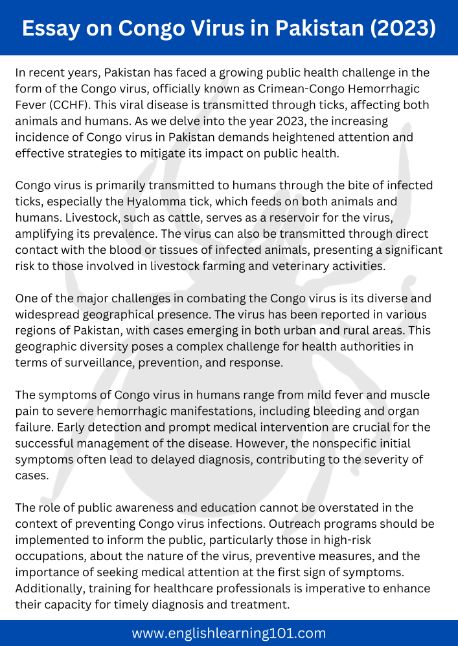Congo Virus in Pakistan (2023)

In recent years, Pakistan has faced a growing public health challenge in the form of the Congo virus, officially known as Crimean-Congo Hemorrhagic Fever (CCHF). This viral disease is transmitted through ticks, affecting both animals and humans. As we delve into the year 2023, the increasing incidence of Congo virus in Pakistan demands heightened attention and effective strategies to mitigate its impact on public health.
Congo virus is primarily transmitted to humans through the bite of infected ticks, especially the Hyalomma tick, which feeds on both animals and humans. Livestock, such as cattle, serves as a reservoir for the virus, amplifying its prevalence. The virus can also be transmitted through direct contact with the blood or tissues of infected animals, presenting a significant risk to those involved in livestock farming and veterinary activities.
One of the major challenges in combating the Congo virus is its diverse and widespread geographical presence. The virus has been reported in various regions of Pakistan, with cases emerging in both urban and rural areas. This geographic diversity poses a complex challenge for health authorities in terms of surveillance, prevention, and response.
The symptoms of Congo virus in humans range from mild fever and muscle pain to severe hemorrhagic manifestations, including bleeding and organ failure. Early detection and prompt medical intervention are crucial for the successful management of the disease. However, the nonspecific initial symptoms often lead to delayed diagnosis, contributing to the severity of cases.
The role of public awareness and education cannot be overstated in the context of preventing Congo virus infections. Outreach programs should be implemented to inform the public, particularly those in high-risk occupations, about the nature of the virus, preventive measures, and the importance of seeking medical attention at the first sign of symptoms. Additionally, training for healthcare professionals is imperative to enhance their capacity for timely diagnosis and treatment.
Given the zoonotic nature of the Congo virus, a comprehensive One Health approach is vital for effective management. This involves collaboration between human health, animal health, and environmental sectors to address the interconnected factors contributing to the spread of the virus. Surveillance of both animal and human populations, along with the control of tick populations, is essential for preventing and controlling outbreaks.
International cooperation is also crucial in the fight against the Congo virus. As a cross-border disease with implications for global health security, collaboration with neighboring countries and international organizations is essential to share information, resources, and best practices. This can help create a unified front against the virus and strengthen the capacity of affected nations to respond effectively.
In conclusion, the emergence of the Congo virus in Pakistan in 2023 poses a serious threat to public health. Addressing this challenge requires a multifaceted approach, including public awareness, healthcare professional training, One Health strategies, and international collaboration. By adopting proactive measures and fostering cooperation, Pakistan can work towards mitigating the impact of the Congo virus and safeguarding the health and well-being of its population.

thank you